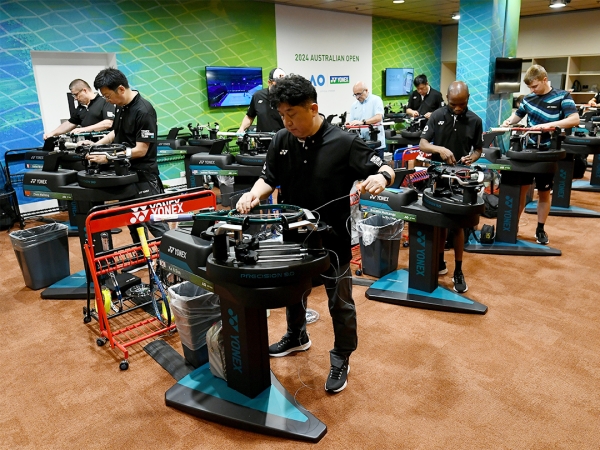While the stars battle it out on court at Rod Laver Arena, unseen, deep in the corridors below, the stringers from the Yonex Stringing Team work their magic to support the stars in their quest for Grand Slam glory.
This team, a diverse crew from all over the world, has a unique influence on the game that could make or break a player's chances in a big match.
MORE: All the results from Australian Open 2024
“You're, in a way, connected to the player,” says Priscilla Mendes from Brazil, who has worked with the team at two previous Australian Opens.
“I'm never going to play professional tennis, so you get the connection to be part of something good.”

Between them, this dedicated team will string up to 7000 racquets at Australian Open 2024, using 12 metres of string per racquet. That's an impressive total of 84 kilometres of string for the tournament.
Over the nine Australian Opens they have been contracted, the Yonex Stringing Team have strung an estimated 57,000 racquets, using enough string to stretch from Melbourne to Sydney, some 700 kms.
“Some players want different tensions. Some players want all the same. Some players, if they have six racquets, want five at one tension and maybe one a little bit tighter,” explains Jim Downes, an American, who has been stringing racquets since 1988.
So, are some players more highly strung than others?
“They can go from as low as the machine can go, 20 pounds down to the maximum the machine can go: 88 pounds today,” says Australia’s Jeremy Reeve, who is working his fifth Australian Open.
Those players can be confident that their racquets are in the best possible hands. At AO 2024, the Yonex Stringing Team, which has also provided services to the past four Olympic and Paralympic Games, is using the high-performance proprietary machines “Precision 9.0” which excel in precision stringing.
BONUS: Download your copy of the Australian Open 2024 Official Program
“Attention to detail really is a big factor,” says Mendes, when asked what it takes to be a good stringer. “You've got to like what you do and really put in an effort to make everything work as perfectly as you can, because it does show in the playability of the racquet and the strings.”
Downes explains the importance of trust.
“In that tournament setting, when you've got players dropping off four, five, six racquets, they get halfway through a match and they want to pull out the racquet and trust it. It's got to be a consistent feeling across the match, across the tournament.”

Some of the more unusual requests, Downes adds, are not limited to string tension.
“There are some players who want us to actually change the shape of their racquet, to have it more rounded or stretch it out,” he says.
Then there are the factors that can suddenly change everything.
“We don't like to see rain because players will want to restring racquets that have already been strung,” says Jim.
Marathon matches can also take a toll, with stringers often called upon to work all kinds of hours. During last year's late-night epic with Thanassi Kokkinakis, Andy Murray went through no fewer than 12 racquets.

“Usually, the players might take five or six racquets going into the match but then they don't expect it to go five hours”, Downes says. “So then throughout the match they've got to get what we call the on-court racquets to keep them topped up, up until 4am in the morning.”
“I don't think people understand the value of how a good stringing job can influence the playability of a racquet” says Mendes. “The strings are, technically, the only part of the game that contacts the ball, so it has an immense influence on the playability.”
With prize money in the millions and valuable ranking points at stake, it takes a top stringer to make sure a star's chances aren't left hanging by a string.